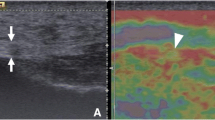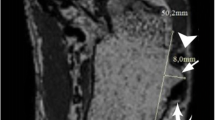Abstract
Objective. To determine the postoperative appearance of the plantar fascia on MR imaging after a fasciotomy has been performed, and to compare the postsurgical appearance of the fascia after an open and endoscopic procedure.<@head-abs-p1.lf>Design and patients. Fifteen asymptomatic volunteers (12 women, 3 men; age range 22–49 years, mean age 33 years) with prior fasciotomies for treatment of longstanding plantar fasciitis were studied. Fourteen volunteers had a unilateral release and one volunteer had bilateral releases, allowing for assessment of 16 ankles. Eight fasciotomies were performed through an open incision and eight were performed endoscopically. The average time between surgery and imaging was 24 months (range 11–46 months). The site of surgery was established from the operative reports. Proton density (PD)-weighted and T2-weighted images in three orthogonal planes were obtained on a 1.5-T magnet. In eight studies, T1-weighted sagittal and STIR sagittal images were included. The fascia in each ankle was assessed for morphology and signal intensity. Perifascial soft tissues and bone marrow were assessed for edema. Preoperative MR studies were available in five volunteers.<@head-abs-p1.lf>Results. There was no apparent difference in the postoperative appearance of the ankle after an open or endoscopic procedure except for scar formation in the subcutaneous fat which was common after an open procedure (P<0.05). Three ankles had a gap in the fascia (one open, two endoscopic). The plantar fascia measured a mean of 7.0 mm (range 5–10 mm) at the fasciotomy, and 8.3 mm (range 6–12 mm) at the enthesis. At the fasciotomy, 11 of 13 ankles had an indistinct deep contour and 9 of 13 had an indistinct superficial contour. At the enthesis, 13 of 16 ankles had an indistinct deep contour and 6 of 16 had an indistinct superficial contour. Compared with preoperative MR studies there was an average reduction in the fascial thickness at the enthesis of 14% (range 9–20%), but the thickness at the fasciotomy nearly doubled. No edema was evident in the fascia, perifascial tissues, deep plantar muscles, or calcaneal bone marrow.<@head-abs-p1.lf>Conclusions. The average thickness of the plantar fascia in asymptomatic volunteers after surgery is nearly 2–3 times that of normal. While there is increased thickness at the site of surgery, the changes in morphology and signal intensity were most prominent at the enthesis. The key observation was absence of edema in the fascia and perifascial soft tissues. This baseline information may be of value when assessing MR studies of symptomatic patients.
Similar content being viewed by others
Author information
Authors and Affiliations
Additional information
Received: 23 March 1999 Revision requested: 19 May 1999 Revision received: 4 June 1999 Accepted: 9 June 1999
Rights and permissions
About this article
Cite this article
Yu, J., Smith, G., Ashman, C. et al. The plantar fasciotomy: MR imaging findings in asymptomatic volunteers. Skeletal Radiol 28, 447–452 (1999). https://doi.org/10.1007/s002560050544
Issue Date:
DOI: https://doi.org/10.1007/s002560050544




